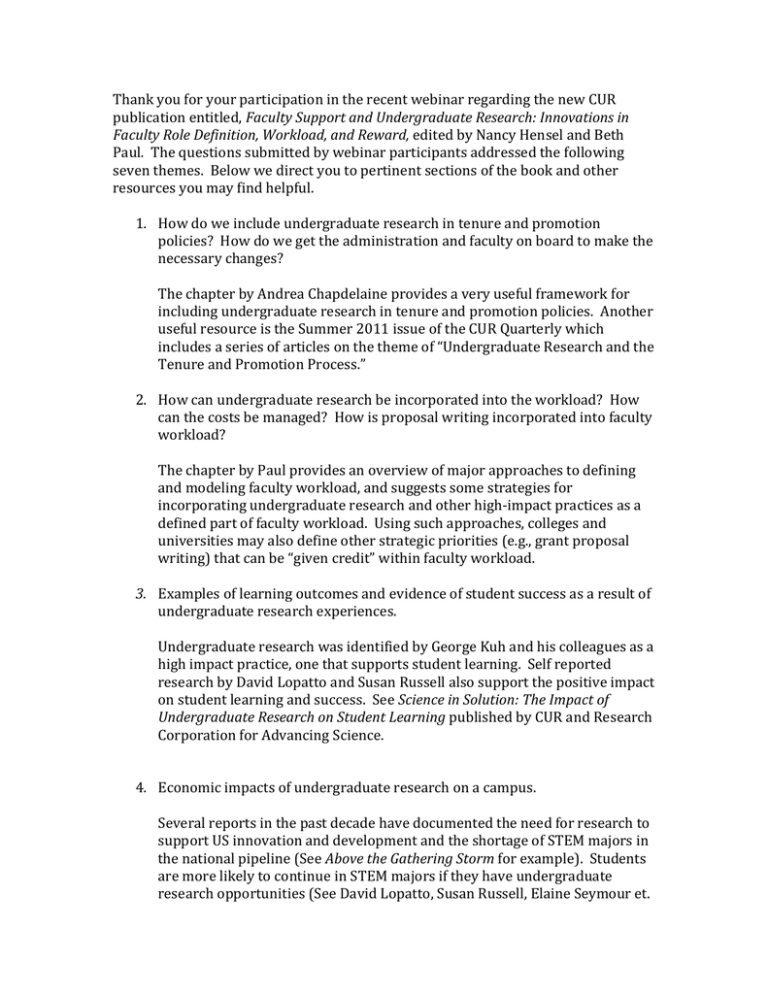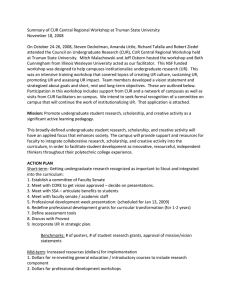Faculty Support and Undergraduate Research Webinar Q&A - February 6, 2013
advertisement

Thank you for your participation in the recent webinar regarding the new CUR publication entitled, Faculty Support and Undergraduate Research: Innovations in Faculty Role Definition, Workload, and Reward, edited by Nancy Hensel and Beth Paul. The questions submitted by webinar participants addressed the following seven themes. Below we direct you to pertinent sections of the book and other resources you may find helpful. 1. How do we include undergraduate research in tenure and promotion policies? How do we get the administration and faculty on board to make the necessary changes? The chapter by Andrea Chapdelaine provides a very useful framework for including undergraduate research in tenure and promotion policies. Another useful resource is the Summer 2011 issue of the CUR Quarterly which includes a series of articles on the theme of “Undergraduate Research and the Tenure and Promotion Process.” 2. How can undergraduate research be incorporated into the workload? How can the costs be managed? How is proposal writing incorporated into faculty workload? The chapter by Paul provides an overview of major approaches to defining and modeling faculty workload, and suggests some strategies for incorporating undergraduate research and other high-impact practices as a defined part of faculty workload. Using such approaches, colleges and universities may also define other strategic priorities (e.g., grant proposal writing) that can be “given credit” within faculty workload. 3. Examples of learning outcomes and evidence of student success as a result of undergraduate research experiences. Undergraduate research was identified by George Kuh and his colleagues as a high impact practice, one that supports student learning. Self reported research by David Lopatto and Susan Russell also support the positive impact on student learning and success. See Science in Solution: The Impact of Undergraduate Research on Student Learning published by CUR and Research Corporation for Advancing Science. 4. Economic impacts of undergraduate research on a campus. Several reports in the past decade have documented the need for research to support US innovation and development and the shortage of STEM majors in the national pipeline (See Above the Gathering Storm for example). Students are more likely to continue in STEM majors if they have undergraduate research opportunities (See David Lopatto, Susan Russell, Elaine Seymour et. al. reports). Some states have supported undergraduate research because they believe that the more prepared students are to do research the greater impact they may have on regional economic development. 5. Impact of UR on faculty research and campus. The Fall 2010 CUR Quarterly addresses this issue. You may find the article Undergraduate Research as Faculty Development by Edward Brush, et. al. particularly helpful. 6. Promoting undergraduate research in the humanities. CUR has two recent books about undergraduate research in the humanities. Both are listed on the CUR website: Creative Inquiry in the Arts & Humanities: Models of Undergraduate Research and Reading, writing, & Research: Undergraduate Students as Scholars in Literary Studies. In addition, on the home page of the CUR website is a section for videos. The video of Posters on the Hill, 2011 will provide student reports on their humanities research. 7. Examples of campuses that have addressed these issues. The Hensel and Paul book includes numerous examples of colleges and universities that are working to address these issues. We also encourage participants to engage in the CUR network to learn about a wide array of colleges and universities that are innovating to institutionalize undergraduate research: attend the biennial CUR conference, participate with a campus team in a CUR institute, search the CUR Quarterly database, send a question to the CUR-L listserv.


